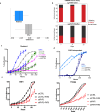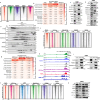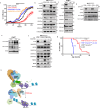PHF6 cooperates with SWI/SNF complexes to facilitate transcriptional progression
- PMID: 39181868
- PMCID: PMC11344777
- DOI: 10.1038/s41467-024-51566-5
PHF6 cooperates with SWI/SNF complexes to facilitate transcriptional progression
Abstract
Genes encoding subunits of SWI/SNF (BAF) chromatin remodeling complexes are mutated in nearly 25% of cancers. To gain insight into the mechanisms by which SWI/SNF mutations drive cancer, we contributed ten rhabdoid tumor (RT) cell lines mutant for SWI/SNF subunit SMARCB1 to a genome-scale CRISPR-Cas9 depletion screen performed across 896 cell lines. We identify PHF6 as specifically essential for RT cell survival and demonstrate that dependency on Phf6 extends to Smarcb1-deficient cancers in vivo. As mutations in either SWI/SNF or PHF6 can cause the neurodevelopmental disorder Coffin-Siris syndrome, our findings of a dependency suggest a previously unrecognized functional link. We demonstrate that PHF6 co-localizes with SWI/SNF complexes at promoters, where it is essential for maintenance of an active chromatin state. We show that in the absence of SMARCB1, PHF6 loss disrupts the recruitment and stability of residual SWI/SNF complex members, collectively resulting in the loss of active chromatin at promoters and stalling of RNA Polymerase II progression. Our work establishes a mechanistic basis for the shared syndromic features of SWI/SNF and PHF6 mutations in CSS and the basis for selective dependency on PHF6 in SMARCB1-mutant cancers.
© 2024. The Author(s).
Conflict of interest statement
The authors declare no competing interests.
Figures






References
MeSH terms
Substances
Supplementary concepts
Grants and funding
LinkOut - more resources
Full Text Sources
Molecular Biology Databases
Research Materials

